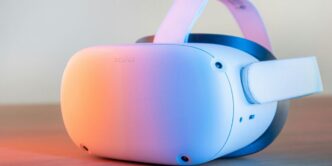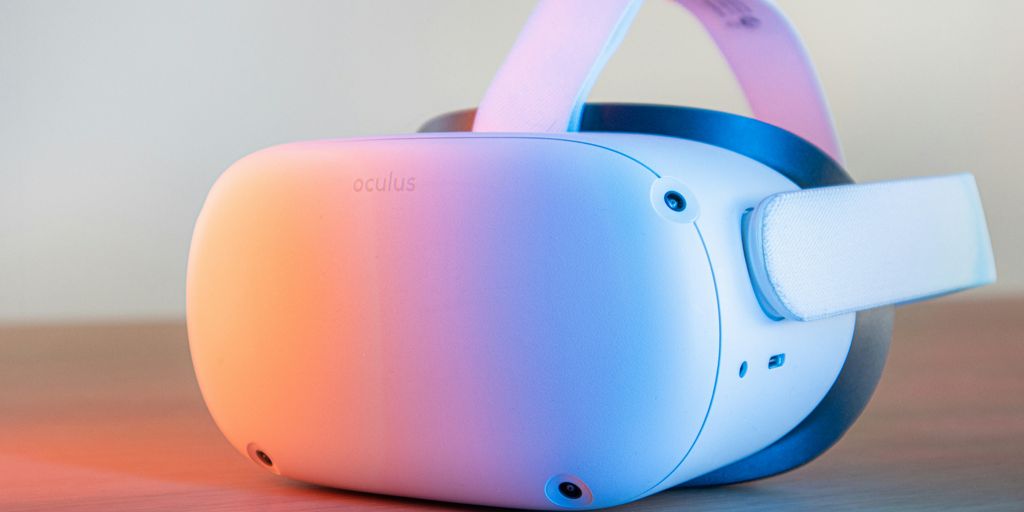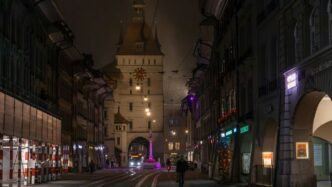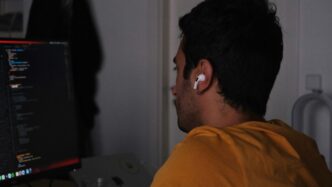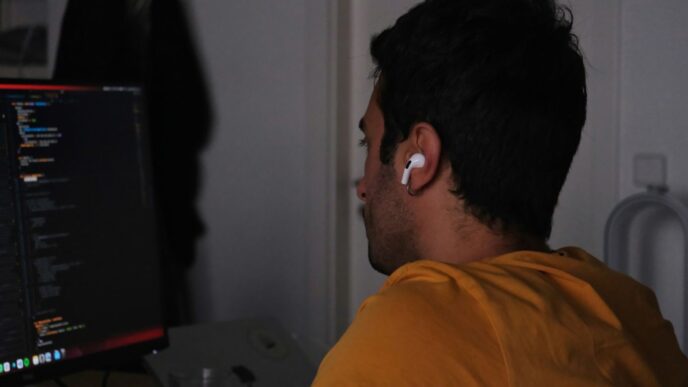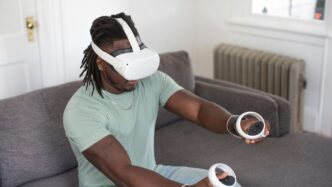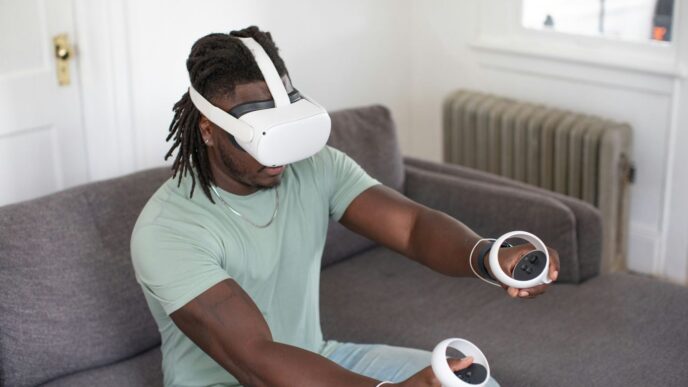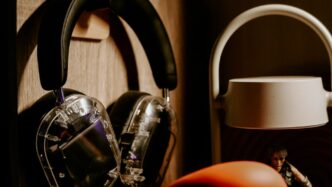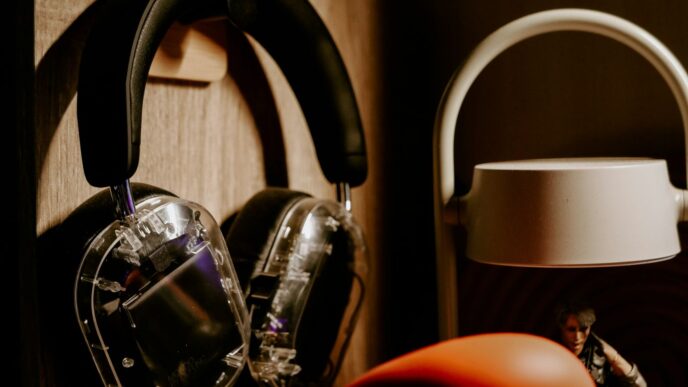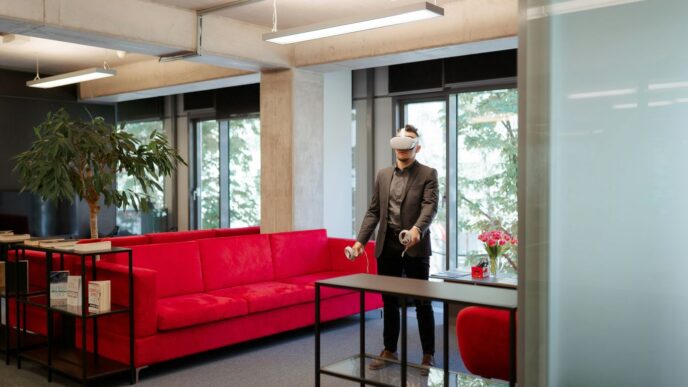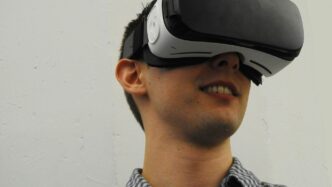Virtual reality has come a long way, and the Bigscreen Beyond is leading the charge with some impressive innovations. This headset aims to tackle the common complaints of VR users—like discomfort and poor visuals—by focusing on comfort, cutting-edge display technology, and eye-tracking features. Let’s take a closer look at what makes the Bigscreen Beyond stand out in the evolving world of virtual reality.
Key Takeaways
- The Bigscreen Beyond is designed for comfort, fitting the user’s face perfectly with custom-made cushions.
- It features high-resolution OLED lenses for sharp visuals and a wide field of view, enhancing immersion.
- The headset is the lightest on the market, making it easier to wear for extended periods without discomfort.
- A new eye-tracking option is available, promising to improve interaction and gameplay experiences.
- While priced higher than some competitors, the features justify the investment for serious VR enthusiasts.
Bigscreen Beyond Redefines VR Comfort
Let’s be real, most VR headsets? They’re clunky. Bigscreen is trying to change that, focusing on comfort. It’s not just about specs; it’s about how the headset feels after hours of use. And that’s where the Bigscreen Beyond is trying to make a difference.
Custom-Made For Your Face
Forget universal fits. The Bigscreen Beyond is custom-made, based on a 3D scan of your face. This means a personalized fit, designed to minimize pressure points and maximize comfort. It’s like getting a tailored suit, but for your face. The original Bigscreen Beyond required you to send in a 3D scan of your face from your iPhone so they could manufacture a face cushion custom-made for your face, with factory-set IPD based on your scan. This approach was adopted with the Beyond 2, while fixing the widely requested issues.
Adjustable IPD Features
One size doesn’t fit all, especially when it comes to interpupillary distance (IPD). The Bigscreen Beyond acknowledges this with adjustable IPD features. This ensures the lenses are perfectly aligned with your eyes, reducing eye strain and improving visual clarity. With Beyond 2, you can adjust the IPD using the screw they’ve given you on the side of the headset. They also have a Halo Mount strap as a purchasable option, which allows you to share your headset with others.
World’s Lightest VR Headset
Weight matters, especially when it’s strapped to your head. The Bigscreen Beyond boasts being the world’s lightest VR headset. This reduction in weight translates to less neck strain and a more comfortable experience, especially during extended VR sessions. Even though the first Beyond goggles were already light, weighing 127g, the Beyond 2’s goggles are further reduced in weight by 15%, weighing 107g. With its lighter weight and incredible lens, you can go for hours on end without experiencing eye fatigue. Its exceptional features make the bulkier VRs look pointless, despite offering higher resolutions. Here’s a quick comparison:
| Headset | Weight (approx.) |
|---|---|
| Bigscreen Beyond | 107g |
| Meta Quest 3 | ~515g |
| Primax Crystal | ~950g |
Innovative Display Technology in Bigscreen Beyond
Bigscreen Beyond really put some thought into their display tech. It’s not just about slapping in any old screen; they’re aiming for a visual experience that’s top-tier. I think they’ve done a pretty good job, honestly.
High-Resolution OLED Lens
The Bigscreen Beyond uses OLED microdisplays, pushing a resolution of 2560×2560 pixels for each eye. That’s a lot of pixels! The result is a super sharp and detailed image, which is what you want when you’re trying to lose yourself in a virtual world. It’s a noticeable step up from some of the older VR headsets I’ve tried. The OLED microdisplays really make a difference.
Edge-to-Edge Clarity
One of the most annoying things about some VR headsets is that the image gets blurry around the edges. Bigscreen is claiming 100% edge-to-edge clarity with the Beyond, which is a big deal. It means that no matter where you look in the headset, the image should stay sharp and clear. This is thanks to their custom pancake optics. I haven’t tried it myself, but if it’s true, it would make a huge difference in immersion.
Wide Field of View
The field of view (FOV) is how much of your vision is filled by the screen. A wider FOV makes the experience feel more natural and less like you’re looking through goggles. The Beyond 2 boasts a 116-degree field of view. Here’s a quick comparison:
- Bigscreen Beyond: 116 degrees
- Valve Index: Around 130 degrees (adjustable)
- Oculus Quest 2: Around 90 degrees
While not the widest on the market, it’s still a solid FOV that should provide a pretty immersive experience. It’s a good balance between immersion and performance, I think.
The Future of Eye-Tracking in VR
Eye-tracking is quickly becoming a must-have feature in VR, and Bigscreen is pushing the boundaries with their implementation. It’s not just about following where your eyes are looking; it’s about creating more realistic and interactive experiences. Let’s take a look at what Bigscreen is doing in this space.
Smallest Eye-Tracking System
Bigscreen had to get creative to fit eye-tracking into their already compact headset. They’ve developed what they claim is the world’s smallest eye-tracking system. The image sensor is tiny, about the size of a grain of sand! This is a big deal because it means they can include the tech without adding bulk or weight to the VR headset.
Collaborations with Industry Leaders
Bigscreen isn’t going it alone. They’re working with some big names like Nvidia, Valve, and various game developers to make sure the eye-tracking features are well-integrated and useful. This collaboration is key to unlocking the full potential of eye-tracking in VR. Imagine games that react to your gaze or interfaces that you can control with your eyes. The possibilities are pretty exciting.
Potential Applications in Gaming
Eye-tracking opens up a whole new world of possibilities for gaming. Here are just a few ideas:
- Foveated Rendering: The headset only fully renders the area you’re looking at, saving processing power and improving performance.
- Gaze-Based Interactions: Select menu items, interact with objects, or even cast spells just by looking at them.
- More Realistic Characters: Characters in the game can react to your gaze, making interactions feel more natural and immersive.
Bigscreen’s eye-tracking variant is expected to ship in July 2025, so we won’t have to wait too long to see these features in action.
Pricing and Value of Bigscreen Beyond
Base Model vs. Eye-Tracking Variant
Okay, let’s talk money. The Bigscreen Beyond isn’t exactly cheap, but is it worth it? The base model will set you back $1019. Now, if you want to jump into the future with the eye-tracking variant, you’re looking at $1219. That’s a $200 jump. Is eye-tracking worth that much? That’s the big question, right? It really depends on how much you value that extra layer of immersion and potential future applications. Bigscreen is working with Nvidia, Valve, and other game developers to add great features to the eye-tracking VR.
Comparative Pricing with Competitors
So, how does the Bigscreen Beyond stack up against the competition in terms of price? Well, it’s definitely not trying to compete with the budget-friendly headsets. It’s more in line with the premium VR experience. It’s cheaper than Apple’s Vision Pro, which is a relief for many. But it’s pricier than something like the Meta Quest 3. You’re paying for that custom fit, the lightweight design, and the high-end display. Here’s a quick comparison:
| Headset | Price (USD) |
|---|---|
| Bigscreen Beyond | $1019 |
| Bigscreen Beyond (Eye-Tracking) | $1219 |
| Meta Quest 3 | ~$500 |
| Apple Vision Pro | ~$3500 |
Justifying the Investment
Is the Bigscreen Beyond worth the investment? That’s the million-dollar question, isn’t it? For VR enthusiasts who prioritize comfort, visual fidelity, and a truly immersive experience, the Bigscreen Beyond is a strong contender. You’re not just buying a headset; you’re buying into a custom-tailored VR experience. Consider these points:
- The custom fit means no more bulky, uncomfortable headsets digging into your face.
- The lightweight design lets you game or watch movies for hours without fatigue.
- The high-resolution display and edge-to-edge clarity provide stunning visuals.
Ultimately, it comes down to your budget and what you’re looking for in a VR headset. If you’re willing to spend a bit more for a premium experience, the Bigscreen Beyond might just be the lightest VR you’ve been waiting for.
User Experience and Immersion
Enhanced Comfort for Long Sessions
One of the biggest hurdles for VR adoption has always been comfort, right? Nobody wants a brick strapped to their face for hours. The Bigscreen Beyond seems to be tackling this head-on (pun intended!). The custom fit is a game-changer, meaning less pressure and a more natural feel. I remember trying a VR headset at a friend’s place, and after just an hour, I had a serious headache. Hopefully, this solves that problem.
Realistic Visuals and Interactions
It’s not just about comfort; it’s about what you see and how you interact. High-resolution OLED lenses are a must, and the edge-to-edge clarity sounds amazing. It’s all about tricking your brain into thinking you’re actually there. I’m curious to see how the eye-tracking smallest eye-tracking system integrates into the experience. Imagine your avatar’s eyes moving realistically – that’s next-level immersion.
Feedback from Early Adopters
Okay, so what are people actually saying? Early reviews are crucial. Are users raving about the comfort? Are the visuals as good as advertised? Word of mouth can make or break a product, especially in the VR space. I’m looking for feedback on:
- How well the custom fit works for different face shapes.
- Whether the high resolution truly eliminates screen-door effect.
- If the eye-tracking feels natural or gimmicky.
I’m eager to see how the Bigscreen Beyond stacks up once it gets into more users’ hands. The potential is definitely there for a truly immersive experience.
Bigscreen Beyond’s Role in the VR Ecosystem
The Bigscreen Beyond isn’t just another VR headset; it’s trying to change the game. It’s pushing boundaries in design and functionality, and that has implications for the whole VR world. Let’s look at how it fits in.
Impact on VR Market Trends
The Bigscreen Beyond is making waves, especially with its focus on being incredibly light and custom-fit. This emphasis on comfort and personalization could push other manufacturers to rethink their designs. We’re already seeing a shift towards more compact headsets, and the Beyond might accelerate that trend. It’s not just about raw power anymore; it’s about making VR something you can wear for hours without fatigue. The price point, while high, also sets a new bar for premium VR experiences, potentially creating a new market segment for high-end, personalized VR.
Comparison with Other Leading Headsets
When you stack the Bigscreen Beyond against other headsets, some key differences emerge. Compared to the Meta Quest 3, the Beyond prioritizes visual fidelity and comfort over standalone capabilities. The Quest 3 is more versatile with its standalone functionality and lower price, but the Beyond offers a more tailored and potentially immersive experience for PC VR enthusiasts. Then there’s the Primax Crystal, which boasts impressive specs but can be bulky. The Beyond aims for a sweet spot: high-end visuals in an ultra-compact form factor. Here’s a quick comparison:
| Feature | Bigscreen Beyond | Meta Quest 3 | Primax Crystal |
|---|---|---|---|
| Weight | Very Light | Moderate | Heavy |
| Custom Fit | Yes | No | No |
| Standalone | No | Yes | No |
| Price (approx.) | $1019+ | $500+ | $1600+ |
Future Developments and Innovations
Looking ahead, Bigscreen’s focus on eye-tracking is a big deal. The integration of the smallest eye-tracking system could lead to more intuitive interfaces and more realistic social interactions in VR. Imagine your avatar mirroring your real-life eye movements – that’s the kind of immersion they’re aiming for. Beyond that, we might see Bigscreen exploring new display technologies to further improve visual clarity and reduce latency. The company’s willingness to collaborate with other industry players, like Nvidia and Valve, suggests they’re open to pushing the boundaries of what’s possible in VR. It will be interesting to see how they continue to innovate and shape the future of virtual reality.
Community and Developer Engagement

Building a Supportive User Community
Bigscreen Beyond isn’t just about the tech; it’s about the people using it. The company seems to be putting a lot of effort into building a strong community. They’re doing this by:
- Hosting regular online events where users can meet and chat.
- Creating forums and social media groups for sharing tips and tricks.
- Actively listening to user feedback to improve the product. This focus on community helps create a sense of belonging and encourages users to stick with the platform.
Encouraging Developer Collaboration
For VR to really take off, developers need to be on board. Bigscreen Beyond is trying to make it easy for developers to create content for their headset. They’re doing this through:
- Providing a well-documented SDK (Software Development Kit).
- Offering support and resources to developers.
- Hosting developer events and hackathons. This helps augmented reality development and ensures a steady stream of new and exciting experiences for users.
Showcasing User-Created Content
One of the coolest things about VR is the ability to create and share your own experiences. Bigscreen Beyond is giving users a platform to do just that. They’re:
- Highlighting user-created content on their website and social media.
- Featuring user-created experiences in their own events.
- Providing tools and resources to help users create and share their content. This not only encourages creativity but also helps to build a more diverse and engaging VR ecosystem. It’s cool to see what people come up with, and it keeps the platform fresh.
Wrapping It Up
In the end, Bigscreen Beyond 2 really shakes things up in the VR world. It’s not just about fancy specs; it’s about making VR comfortable and fun. With its lightweight design and sharp visuals, it feels like they’ve finally nailed what users want. Sure, the price tag is a bit steep, but for what you get, it might just be worth it. As we look ahead, it’s clear that VR is only going to get better. Bigscreen is leading the charge, and it’ll be exciting to see how they keep pushing the boundaries. If you’re into VR, keep an eye on what’s next from them.
Frequently Asked Questions
What makes Bigscreen Beyond comfortable to wear?
Bigscreen Beyond is designed to fit your face perfectly. You send a 3D scan of your face, and they create a custom headset just for you. This means it won’t feel heavy or uncomfortable, even during long gaming sessions.
How does the display quality of Bigscreen Beyond compare to other VR headsets?
The headset has a high-resolution OLED lens that gives clear images. It offers great edge-to-edge clarity and a wide field of view, making everything look realistic and immersive.
What is unique about the eye-tracking feature in Bigscreen Beyond?
Bigscreen Beyond has the smallest eye-tracking system ever made, which is tiny enough to fit in the headset. This allows for new gaming experiences and interactions, and it’s being developed with help from big companies like Nvidia.
How much does Bigscreen Beyond cost?
The base model of Bigscreen Beyond costs $1019, while the version with eye-tracking is priced at $1219. While it’s not the cheapest option, it offers many advanced features.
What do users think about their experience with Bigscreen Beyond?
Early users have reported that the headset is very comfortable and offers stunning visuals. They appreciate how it feels light and allows them to play for hours without discomfort.
How does Bigscreen Beyond fit into the larger VR market?
Bigscreen Beyond is changing the VR landscape by focusing on comfort and performance. It competes with other leading headsets and is setting new standards for what users can expect from VR technology.

